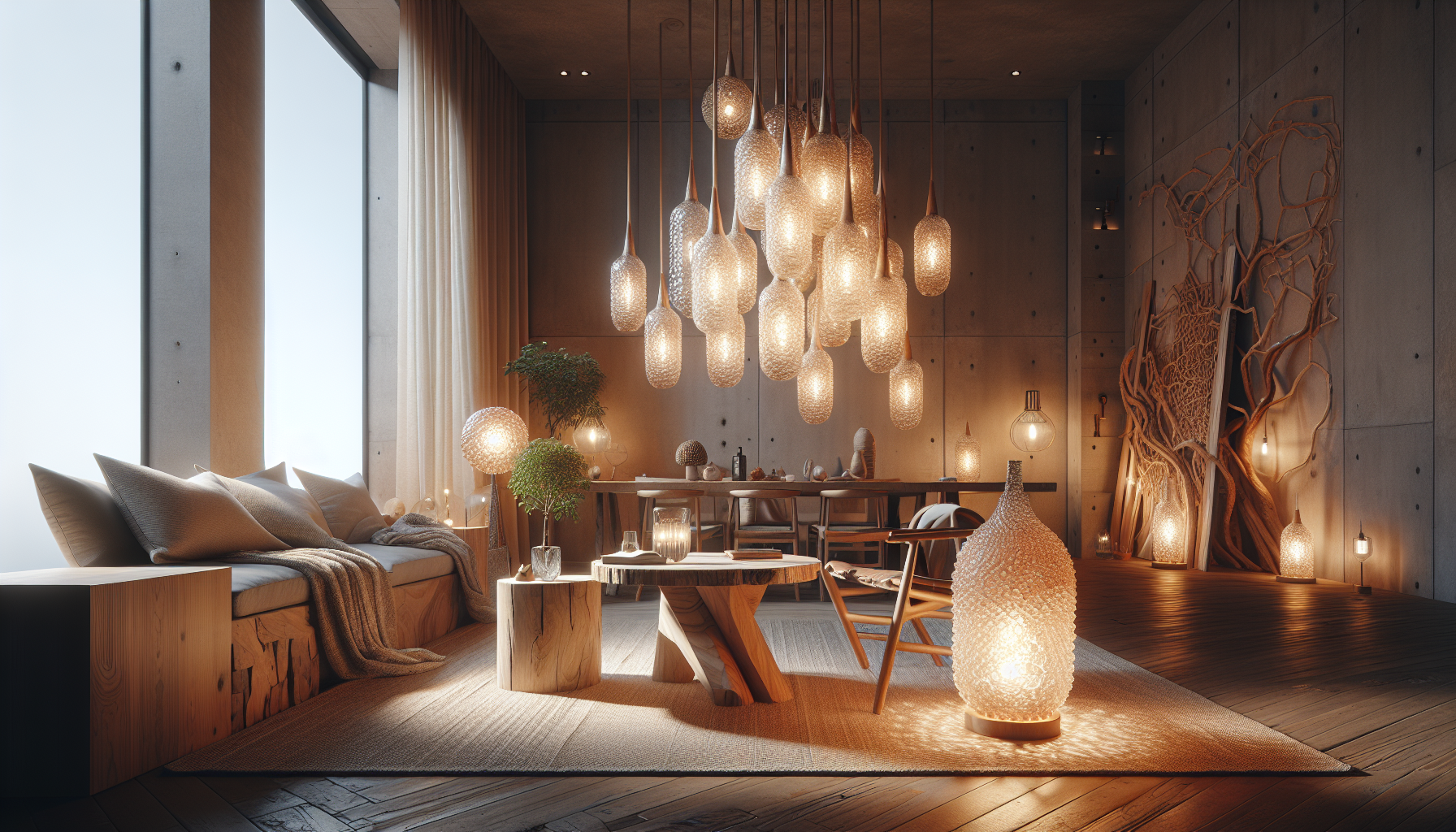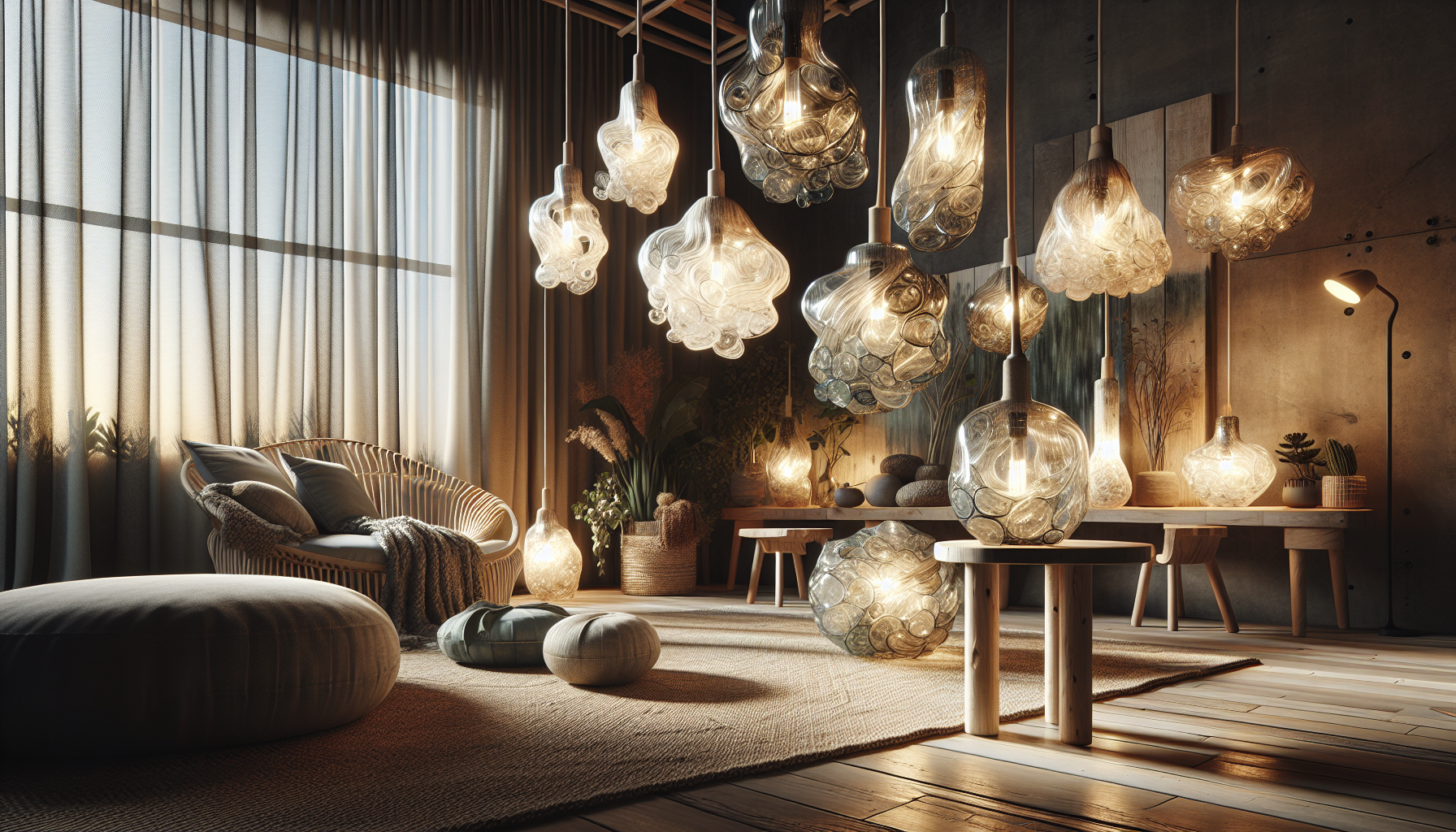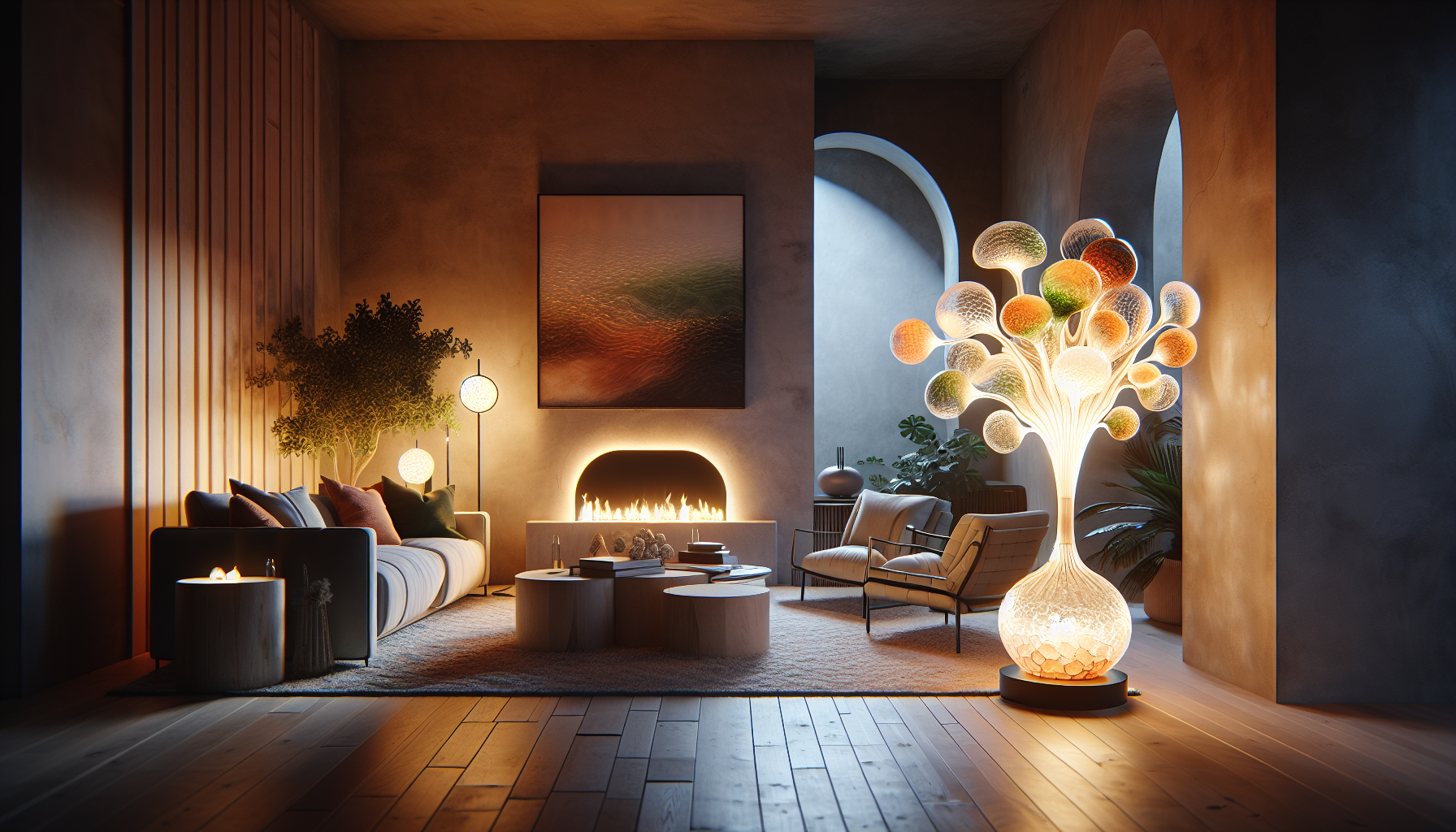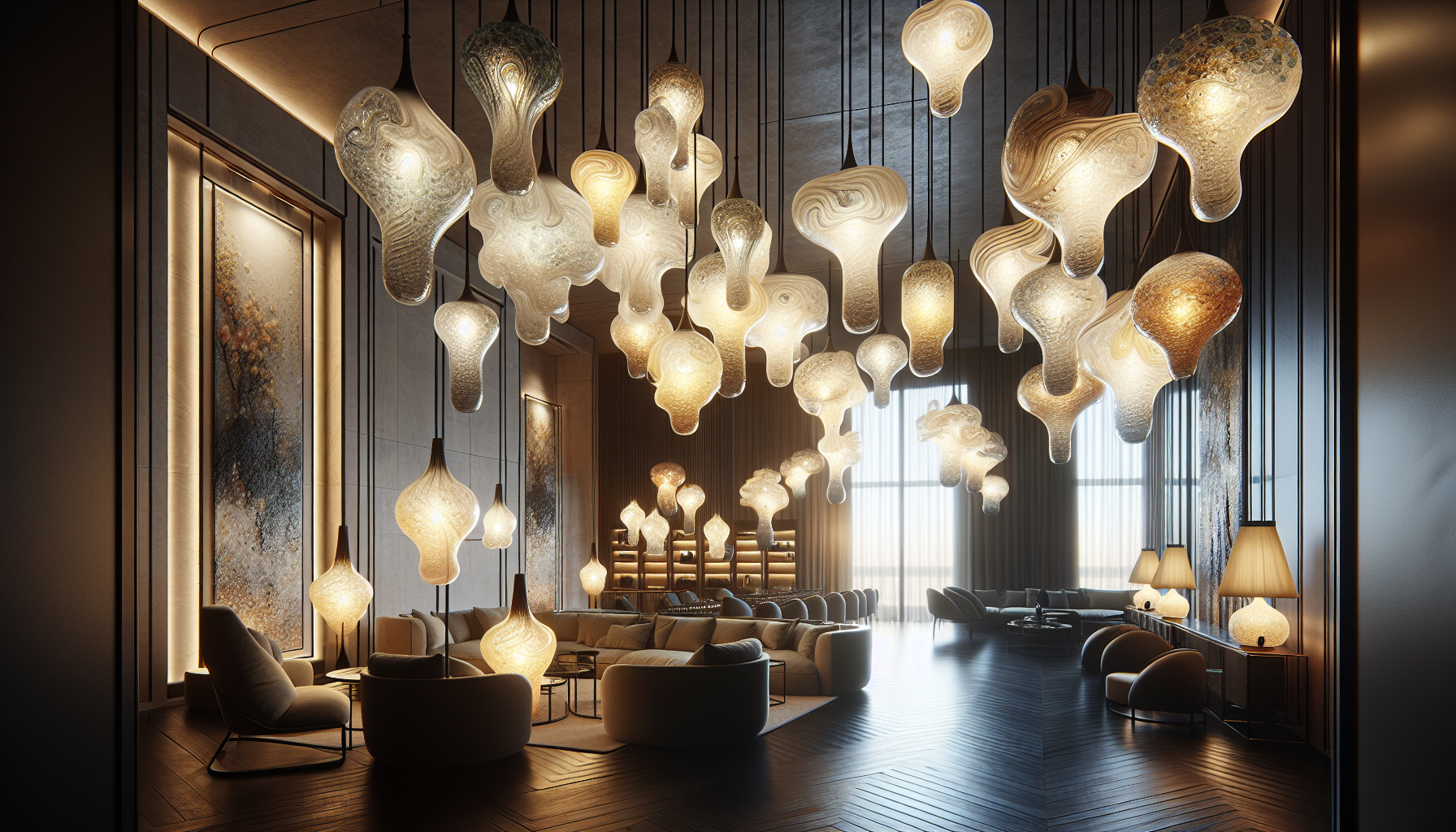In a world where sustainability and style are no longer mutually exclusive, the fusion of eco-conscious living and aesthetic appeal has become a captivating trend. As the conversation around environmental responsibility intensifies, so does our desire to incorporate more sustainable practices into our daily lives. Enter the realm of handcrafted sculptural lamps made from upcycled glass bottles—a marriage of art, functionality, and environmental stewardship. These unique lighting pieces not only illuminate your space but also tell a compelling story of transformation and creativity. 🌿
Imagine transforming what once was considered waste into a beacon of elegance and innovation. Each lamp, meticulously crafted by artisans who see potential in the discarded, offers a unique narrative shaped by the distinctive characteristics of the glass bottles from which they emerge. This blog post will delve into the enchanting world of these eco-friendly luminaries, exploring how they can serve as both a statement piece in your home and a symbol of your commitment to sustainable living. From the intricate process of selecting and preparing the bottles to the careful design considerations that ensure both beauty and functionality, we’ll uncover the artistry and ingenuity behind these luminous sculptures.
Throughout this article, we will journey through the benefits of choosing upcycled glass lamps, examining how they contribute to a reduced carbon footprint and promote a circular economy. We’ll also highlight some inspiring examples of designs that range from minimalist to extravagant, catering to a variety of tastes and home aesthetics. Furthermore, we’ll provide practical tips on how to integrate these elegant lamps into your interior decor, ensuring they complement and enhance your existing style. As you read on, prepare to be inspired by stories of artisans who have mastered the delicate balance between creativity and environmental responsibility, ultimately offering a product that not only illuminates spaces but also ignites conversations. 💡
The Art of Eco-Friendly Design
The rise of eco-consciousness in recent years has significantly influenced various industries, including interior design. A noteworthy trend is the utilization of upcycled materials to create beautiful, sustainable decor items. Among these, sculptural lamps crafted from upcycled glass bottles stand out as both innovative and environmentally friendly. This fusion of art and sustainability not only reduces waste but also adds a unique aesthetic to any space. In this section, we will explore how artisans transform discarded glass bottles into stunning pieces of art, contributing to the eco-friendly movement.
The process begins with the selection of glass bottles, which are often sourced from local recycling centers or collected through community initiatives. These bottles are then meticulously cleaned and sorted according to color and size, laying the foundation for the creative process. Artists employ various techniques to transform these bottles into lamps, including cutting, etching, and molding. Each method requires precision and skill, resulting in a product that is both functional and decorative.
The popularity of these eco-friendly lamps has surged as more consumers seek sustainable alternatives for their home decor. They not only reduce the environmental impact by repurposing materials that would otherwise end up in landfills but also add a touch of elegance and uniqueness to interior spaces. Moreover, each lamp tells a story, reflecting the artist’s vision and the journey of the materials used. The following sections will delve deeper into the techniques used, the environmental benefits, and the diverse styles available.
Techniques in Crafting Upcycled Glass Lamps
Creating lamps from upcycled glass bottles is an intricate process that involves several artistic techniques. One of the most common methods is glass cutting, where artisans carefully slice the bottles to achieve the desired shape. This technique requires not only precision but also creativity, as artists must envision how the final piece will look once assembled. Glass cutting often serves as the first step in the transformation process, laying the groundwork for additional decorative methods.
Another popular technique is etching, which involves carving intricate designs into the surface of the glass. Etching allows artists to add a personal touch to their creations, enhancing the lamp’s aesthetic appeal. This method can range from simple patterns to complex, detailed artwork that highlights the artist’s skill and creativity. Each etched design is unique, making every lamp a one-of-a-kind piece.
Molding is also a technique employed by some artisans, where the glass is heated until it becomes malleable and then shaped into the desired form. This method allows for the creation of more abstract and sculptural designs, providing a dynamic element to the lamp. The combination of these techniques results in a diverse array of styles, from minimalist and modern to ornate and traditional.
Environmental Benefits of Upcycling Glass
Upcycling glass bottles into sculptural lamps presents numerous environmental benefits, making it an attractive option for eco-conscious consumers. One of the primary advantages is the reduction of waste, as glass is a material that is notoriously difficult to decompose. By repurposing glass bottles, artisans help mitigate the accumulation of waste in landfills, contributing to a cleaner, more sustainable environment.
Moreover, the process of upcycling glass requires significantly less energy compared to traditional glass recycling. Recycling glass involves melting it down, which is energy-intensive and contributes to carbon emissions. In contrast, upcycling utilizes existing materials, reducing the need for energy and lowering the overall carbon footprint. This makes upcycled glass lamps an eco-friendly alternative that aligns with sustainable living practices.
In addition to reducing waste and energy consumption, upcycled glass lamps promote local economies by supporting artisans and small businesses. Many artists who create these lamps operate on a small scale, often sourcing materials locally and selling their creations in local markets or online platforms. By choosing to purchase upcycled glass lamps, consumers can contribute to sustainable development and support communities dedicated to eco-friendly practices.
Diverse Styles and Designs
One of the most appealing aspects of upcycled glass lamps is the wide range of styles and designs available, catering to various tastes and interior aesthetics. Whether you prefer a modern, minimalist look or a more traditional, ornate design, there is likely an upcycled glass lamp that suits your style. This versatility is made possible by the creativity and skill of the artisans, who experiment with different techniques and materials to create unique pieces.
For those who appreciate a minimalist approach, many artisans offer sleek, simple designs that highlight the natural beauty of the glass. These lamps often feature clean lines and subtle patterns, allowing the light to shine through and create a calming, elegant ambiance. On the other hand, if you prefer a more elaborate design, there are numerous options featuring intricate etchings and vibrant colors that add a touch of whimsy and artistic flair to any space.
In addition to traditional table and floor lamps, upcycled glass can also be used to create pendant lights and chandeliers, providing even more options for incorporating eco-friendly lighting into your home. These statement pieces serve as both functional lighting solutions and captivating works of art, making them a focal point in any room. To see a stunning example of these designs in action, watch the video titled “Sculptural Lamps from Recycled Glass Bottles” on the Sustainable Design channel.
Comparative Analysis of Traditional vs. Upcycled Glass Lamps
When considering the purchase of a new lamp, it’s important to weigh the benefits and drawbacks of traditional glass lamps versus those made from upcycled materials. Traditional glass lamps are often mass-produced, which can lead to a lack of uniqueness and personality. In contrast, upcycled glass lamps are typically handcrafted, resulting in one-of-a-kind pieces that reflect the artist’s vision and creativity.
From an environmental perspective, upcycled glass lamps have a clear advantage. Traditional glass production is resource-intensive, involving the extraction of raw materials and significant energy consumption during manufacturing. Upcycled glass, on the other hand, repurposes existing materials, reducing the demand for new resources and minimizing the environmental impact. This makes them a more sustainable option for eco-conscious consumers.
The following table provides a comparative analysis of traditional and upcycled glass lamps in terms of various factors, including environmental impact, cost, and aesthetic appeal:
| Factor | Traditional Glass Lamps | Upcycled Glass Lamps |
|---|---|---|
| Environmental Impact | High (resource-intensive production) | Low (repurposes existing materials) |
| Cost | Variable (often lower for mass-produced items) | Variable (can be higher due to artisanal nature) |
| Aesthetic Appeal | Standardized (mass-produced) | Unique (handcrafted, varied designs) |
| Support for Local Economies | Limited | High (supports artisans and small businesses) |
Ultimately, the choice between traditional and upcycled glass lamps will depend on your personal values and aesthetic preferences. If sustainability and uniqueness are important to you, then an upcycled glass lamp may be the ideal choice for your home. Not only will you be investing in a beautiful, handcrafted piece, but you’ll also be supporting sustainable practices and contributing to a greener planet.

Conclusion
In concluding our exploration of the transformative potential of eco-friendly elegance, particularly through the lens of handcrafted sculptural lamps made from upcycled glass bottles, we find ourselves at the intersection of art, sustainability, and functionality. This journey has been illuminating, in both a literal and metaphorical sense, underscoring how thoughtful design and environmental consciousness can beautifully coexist.
Throughout this article, we have delved into several key points that outline the significance of choosing sustainable options in home decor. Initially, we explored the alarming environmental impact of waste, particularly glass, which often ends up in landfills despite being a fully recyclable material. According to the Environmental Protection Agency, millions of tons of glass waste are generated each year, yet a substantial portion remains unrecycled, contributing to environmental degradation. By repurposing glass bottles into sculptural lamps, we reduce this waste and extend the lifecycle of a material that can be continuously reinvented.
Furthermore, we discussed the artisanal process involved in crafting these lamps. Each lamp is not merely a source of light but a piece of art, reflecting the creativity and skill of the artisans. The unique shapes and textures of the bottles, combined with innovative design, result in pieces that are as functional as they are aesthetically pleasing. This aspect highlights the importance of supporting local artisans and recognizing the value of handmade goods, which often carry a smaller carbon footprint compared to mass-produced items.
In addition to environmental and artistic considerations, we also touched upon the economic benefits of upcycling. By transforming what would otherwise be waste into valuable products, we not only create economic opportunities for artisans but also promote a circular economy. This approach encourages consumers to view waste as a resource, thereby fostering a more sustainable and responsible consumption pattern.
The aesthetic appeal of these sculptural lamps cannot be overstated. They serve as conversation pieces, sparking dialogue about sustainability and design among guests and homeowners alike. Their unique glow and intricate craftsmanship add a touch of elegance to any space, proving that eco-friendly choices do not require compromising on style or quality.
Moreover, we examined the broader implications of embracing eco-friendly decor. Making conscious choices in our homes reflects our commitment to the environment and sets a precedent for sustainable living. It also inspires others to consider how they can incorporate sustainability into their own lives, creating a ripple effect that extends beyond individual actions.
As we reflect on these insights, it becomes clear that the decision to illuminate our spaces with eco-friendly elegance is not just a personal choice but a collective movement towards a more sustainable future. Each lamp represents a step towards reducing waste, supporting artisans, and fostering a culture of creativity and environmental responsibility.
In closing, we encourage you, our reader, to reflect on how you can apply these principles in your own life. Consider the potential of upcycled materials in your decor, support local artisans, and engage in conversations about sustainability. By doing so, you contribute to a more sustainable world while enhancing the beauty and uniqueness of your space.
We invite you to share your thoughts and experiences in the comments below. How have you incorporated sustainable practices into your home? What role does art play in your understanding of sustainability? Your insights are valuable and can inspire others on their journey towards eco-friendly living.
Feel free to share this article with friends and family who may be interested in sustainable design or looking for ways to make their spaces more environmentally friendly. Together, we can illuminate the path to a greener future, one handcrafted lamp at a time. 🌿💡
For further reading on sustainable practices and the benefits of upcycling, consider visiting resources like the Environmental Protection Agency and Upcycle That. These platforms offer a wealth of information on how we can all contribute to a more sustainable planet.
Thank you for joining us on this enlightening journey. May your home shine brightly with the warmth of eco-friendly elegance, inspiring change and creativity in every corner.
Toni Santos is a lighting artisan and visual explorer who designs atmospheres, not just objects. With a refined sensitivity to form, reflection, and emotion, Toni’s work at Sordux is an ode to how light transforms space, feeling, and story.
Through his handcrafted creations — from artistic glass bottles to radiant lighting totems — Toni invites us to see light as more than function. To him, light is symbolic. It is memory, energy, and meaning in motion.
Drawing inspiration from modern minimalism, ancestral aesthetics, and organic shapes, Toni blends natural materials with ambient expression. His collections are not just decorative — they’re immersive experiences, each one crafted to awaken the senses and reconnect us to the spaces we inhabit.
As the mind behind Sordux, Toni curates a world where illumination becomes ritual, and where every design element — from the curvature of a bottle to the hue of a glow — speaks of intention and presence.
🔥 His vision shines through:
-
Designs that merge mood with form
-
Bottled light as symbolic storytelling
-
Sustainable aesthetics rooted in artistic function
Whether you’re a designer, a dreamer, or someone who understands that light is a language of its own, Toni invites you into a world where glow becomes meaning, and every beam is an invitation to feel.




